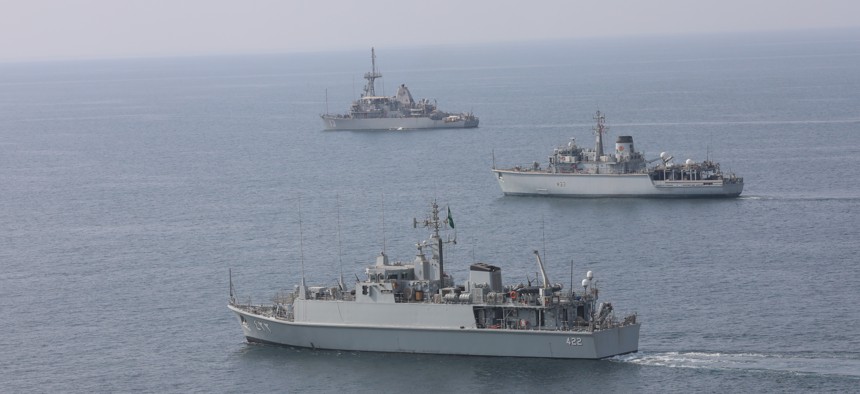
Royal Saudi Naval Force mine countermeasures vessel Al-Shaqra, front, Royal Navy mine countermeasures vessel HMS Brocklesby, and mine countermeasure ship USS Dextrous sail during a 2020 training exercise in the Persian Gulf. Spc. William Gore
How to Advance US-Saudi Defense Cooperation
There’s room for progress short of a formal alliance.
Saudi Arabia has made it clear that it wants a defense pact with the United States in return for normalizing ties with Israel. However, that isn’t a price Washington is able or willing to accept, for both political and strategic reasons. But the conversation about improved U.S.-Saudi defense cooperation shouldn’t stop here. There’s plenty of room for achieving that objective without having to upgrade the relationship to a full-fledged alliance.
But first, it’s important to briefly reiterate why a stronger U.S.-Saudi security relationship serves both parties, and ultimately, regional stability. For Washington, a Saudi Arabia that can defend itself, is capable of operating with U.S. forces, and can provide meaningful contributions to regional security is in the U.S. national interest. A more capable Saudi Arabia also frees the United States to put more military resources in the Indo-Pacific and European theaters.
For Saudi Arabia, the United States is the only country that can help Riyadh achieve its defense restructuring goals and pull other regional partners into any sort of effective regional defense coalition. Recent closeness in Saudi-Chinese relations notwithstanding, Saudi leaders know full well that although Beijing can sell military hardware (not very good hardware), it simply cannot offer geopolitical leadership like Washington.
It’s true that politics, bureaucracy, and differences in values stand in the way of deeper U.S.-Saudi security ties. But there’s something more basic and more practical that has restricted the security relationship for decades: the human element. Indeed, a major challenge that can and should be addressed by both sides is the kingdom’s lack of trained and ready military personnel.
Saudi Arabia is one of the biggest defense spenders in the world and the largest foreign military sales customer of the United States. Most of Saudi Arabia’s defense acquisitions are U.S.-supplied. Saudi Arabia spends twice as much as Iran, its main adversary, on defense. Yet the kingdom has insufficient defense capability, which starts with strong human capital, both in society and in the military.
Saudi leaders understand this and have made investments to address it. Under Saudi Vision 2030, Riyadh has sought to develop the Saudi workforce through education, training, and modernization. In the defense sector, the Saudi transformation plan (which preceded Vision 2030) aims to build not only a capable force but also a more competent civilian cadre of defense professionals in the Saudi Ministry of Defense.
Yet progress remains slow, largely because in many areas Saudi Arabia is starting from scratch. If the kingdom is to create a more joint military that can conduct effective operations by itself and with the United States and other friendly powers, it has to develop and manage its human resources because this is where the political, economic, and cultural issues of defense reform all come down hardest.
There will always be limits to how much the United States can get involved in this sensitive area and how much it can actually help, given the political challenges and cultural dissimilarities. But out in the field, there are ways for the U.S. military to play a useful role.
Thanks to years of work by the Bahrain-based U.S. Naval Forces Central Command, or NAVCENT, the template is there. The idea is to have Saudi and U.S. forces operate consistently in the region. Joint military exercises must be more frequent if they are to build trust, mutual understanding, and interoperability.
For example, the Red Sands exercise—the first joint counter-drone exercise to be completed on March 24 by the Saudi and American forces—is promising, but it could be more effective if paired with daily operations that can build muscle memory and real capability.
Each side has a responsibility for making this work. Leadership in Washington must authorize and enable U.S. Central Command to create a more comprehensive menu and consistent tempo of joint operations and training activities with the Saudi military. Riyadh should get more serious about recruiting and empowering male and female officers, soldiers, sailors, and airmen that would form the nucleus of the Saudi military, along with a companion plan to sustain that effort. Saudi Arabia is fortunate to have one of the youngest workforces in the world. Drawing upon that talent pool for military development should be a priority.
The Saudi military would benefit by working with CENTCOM to develop an aggressive plan to train on operations focused on maritime security and air and missile defense (and the supporting elements, including a shared air and maritime picture and fused intelligence). NAVCENT’s Fifth Fleet has developed Task Forces designed to counter Iranian nefarious activity in both the Gulf and the Red Sea. Riyadh should not only support these missions but start to drive them as Saudi capabilities evolve.
None of this work on the human element of U.S.-Saudi security cooperation is easy. It will take time given the weaknesses in the Saudi system and the lack of commitment and organization on the American side. But the point is that this critical element of an upgraded US-Saudi security partnership shouldn’t be a hostage to high-level problems in Washington and Riyadh. A bottom-up approach is necessary in this case, and could have escalating effects.
Kevin Donegan is a former NAVCENT commander. Bilal Y. Saab is a former senior advisor in the Office of the Secretary of Defense. Both are currently senior fellows in the Middle East Institute in Washington, D.C.

